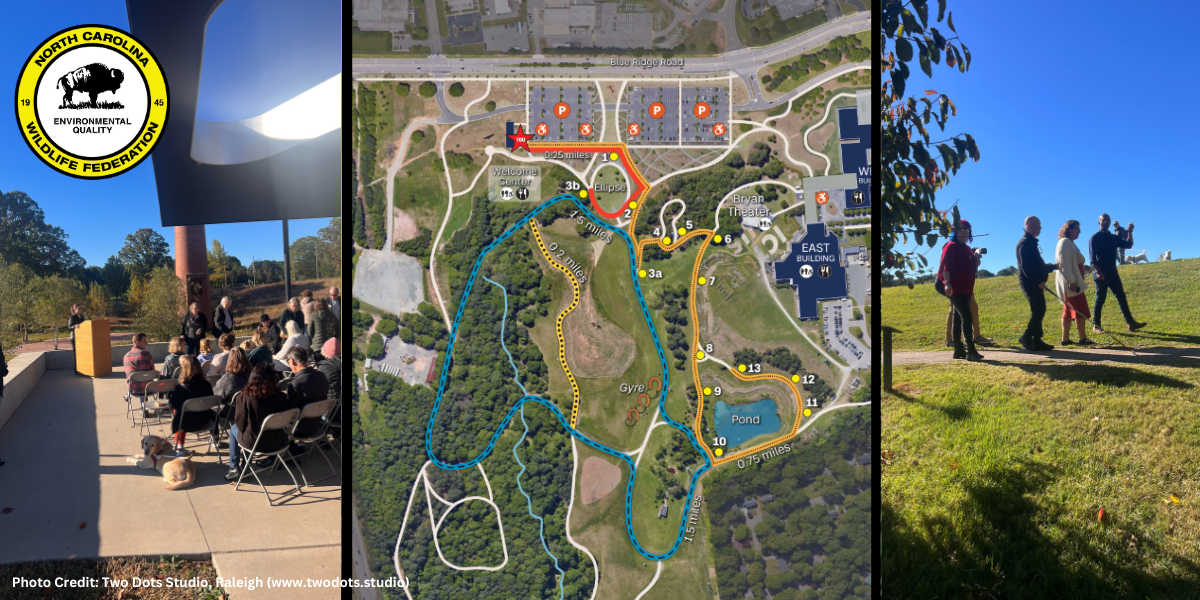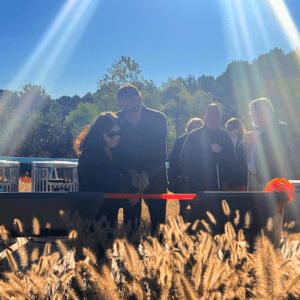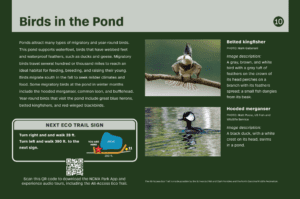NCWF and the North Carolina Museum of Art Celebrate the Opening of All Access Eco Trail


Photo Credit: Two Dots Studio, Raleigh (www.twodots.studio
In October, 2023, a ribbon cutting ceremony was held at the North Carolina Museum of Art’s Ann and Jim Goodnight Park for the opening of a brand new All Access Eco Trail. Made in partnership between NCMA and the North Carolina Wildlife Federation, the All-Access Eco Trail is a series of braille and tactile signs, as well as full audio descriptions, designed to educate both visually impaired and sighted audiences.
The signage and audio lead participants along a pathway through different habitats with diverse wildlife. Depending on the route taken, the trail ranges between 0.25 and 0.75 miles.
The goal is for the trail to provide free and easy access both to educate about North Carolina wildlife and habitat, and provide an opportunity for peaceful outdoor recreation – opportunities that will be available for all, across the spectrum of physical ability.
October’s celebration included members of the NCMA Accessibility Stakeholder Committee (ASC), trail designers and program leads, NCWF VP of Conservation Policy Manley Fuller, and NCWF board member Dr. Bob Brown.
“The North Carolina Museum of Art is a state icon, especially with its walking trails, gardens and outdoor art exhibits. The NCWF has participated in many of the tree and wetland plantings that beautify the grounds.” Said Dr. Brown, “The opening of the All Access Eco Trail not only enhances the beauty of the landscape, but enhances the educational aspect of walkway and opens a new realm of outdoor experiences for visually impaired visitors. The NCWF is proud to have been a part of the development of this new experience.”
Visitors to the All Access Eco Trail will have the opportunity to stroll across the museum’s beautiful campus and observe a variety of species of native plants and wildlife, alongside descriptions of the species on the trailside signs.
 “Songbirds are abundant throughout the Park—in the meadows, woodlands, and wetlands.” Reads one of the signs, alongside a tactile image of a Brown thrasher and Golden-crowned kinglet, “Songbirds belong to the order passerines and can control a specialized vocal organ called a syrinx to produce a succession of musical notes. Listen for variations among the following examples of birdsong you might hear in the Museum Park: brown thrasher, golden crowned kinglet, or American crow.”
“Songbirds are abundant throughout the Park—in the meadows, woodlands, and wetlands.” Reads one of the signs, alongside a tactile image of a Brown thrasher and Golden-crowned kinglet, “Songbirds belong to the order passerines and can control a specialized vocal organ called a syrinx to produce a succession of musical notes. Listen for variations among the following examples of birdsong you might hear in the Museum Park: brown thrasher, golden crowned kinglet, or American crow.”
But species descriptions doesn’t stop at songbirds. Other wildlife species highlighted along the trail include: the Snowberry clearwing, Leaf cutter bee, Spring peeper, Belted kingfisher, Great blue skimmer and Northern water snake. Among the highlighted native plant species are: Eastern bluestar, Rattlesnake master, Shortleaf pine, Dwarf fothergilla and persimmon.
The trail provides a unique experience to engage with a snapshot of North Carolina’s vibrant ecosystems. But it also provides a space for community to come together and celebrate wildlife and habitat.
The All-Access Eco Trail is free and open to the public! On your next trip to Raleigh, you can give it a visit at: 2110 Blue Ridge Road, Raleigh, NC, 27607.
If you make it out to the All Access Eco Trail, make sure to snap some photos of your experience – and the wildlife you encounter. Post them on social media and tag North Carolina Wildlife Federation for a chance to be featured on our page!
Written by:

– Bates Whitaker, NCWF Communications & Marketing Manager

